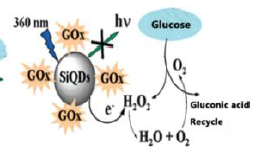Application of Silicon Nanoparticles-Based Sensors: Silicon-Based Surface Enhanced Raman Scattering, High Energy Material Sensing, Glucose Sensing Dopamine Sensing, Antibiotic and Biological Sensing
Keywords:
Silicon Nanoparticles, Silicon-Based Surface, High Energy, Glucose Sensing Dopamine Sensing, Biological SensingAbstract
It is of special importance to design a ratiometric sensor using silicon nanoparticles. New research suggests that by modifying the size and surface modification groups of silicon nanoparticles, their fluorescence may be tuned across the whole visible spectrum. More accurate quantitative measurements with a better signal-to-noise ratio are possible with the dual emission technique that uses silicon nanoparticles. Building multi-detection systems is another use case. Also, by fine-tuning the reaction and fluorescence of silicon nanoparticles, one can accomplish such a multiple detection system. In these setups, we selectively mix several target analytes using silicon nanoparticles with various surface groups. Without the use of harmful metals, it is possible to detect numerous analytes simultaneously in this manner. The impact of surface groups on conductivity and fluorescence is one of several outstanding issues, despite the fact that silicon nanoparticle production and surface modification have come a long way. Although different surface functional groups can cause silicon nanoparticles to exhibit varied fluorescence, the specific process by which this occurs remains unclear. Similarly, there has been very little investigation into how different surface modification groups affect the electrical structure of silicon nanoparticles. We can tailor the silicon nanoparticles to the analysis object's reduction potential if we can determine the effect of surface groups on the band edge. To better build sensors using silicon nanoparticles, it is helpful to have a firm grasp of these fundamental characteristics. Also, we need to find ways to modify surfaces that work better. Because most functional modifications to the material's surface cannot reach every surface, there may be areas that are susceptible to oxidation. Many synthetic silicon nanoparticles will have their surface modification layers changed, rendering them unusable for future sensor manufacture; this will impede their commercial development and production. Silicon nanoparticles have a low quantum yield, which is a major drawback when compared to other semiconductor quantum dots. To enhance the quantum yield, we can refine the surface modification technique and link more surface ligands to enable the detection of more targeted analytes. Quantum dot fluorescence can be significantly impacted by the weak contact between surface ligands and analytical objects. Additional research and development is required to perfect the process of creating hybrid materials using silicon nanoparticles. Could we possibly create a more efficient FRET-based sensor by combining silicon nanoparticles with polymers, dyes, and carbon dots? Alternatively, in SERS sensors based on silicon nanohybrids, the increase of SERS is derived from the plasmon resonance interaction of metal nanoparticles and the effective plasmon resonance coupling between metal nanoparticles and adjacent silicon substrates. Secondly, the SERS signals are guaranteed by the closely defined plasmonic nanoparticles on the silicon wafer or silicon nanowires. To take advantage of these features, various silicon nanohybrids have been used to create SERS sensors that are high-quality, portable, inexpensive, sensitive enough, specific enough, reproducible, and capable of multiplexing detection. These hybrids can be decorated with graphene, gold, silver nanoparticles, silicon nanowires, or silicon wafer, among others. This laid the groundwork for the development of sensitive, selective, and multiplexed SERS sensing systems based on silicon, which allowed for the sensitive, molecular-to-cellular-level examination of a wide range of targets.
Downloads
References
Tan, J.; Xu, L.; Li, T.; Su, B.; Wu, J. WuImage-Contrast Technology Based on the Electrochemiluminescence of Porous Silicon and Its Application in Fingerprint Visualization. Angew. Chem. Int. Ed. 2014, 53, 9822–9826.
Lin, G.; Ding, H.; Yuan, D.; Wang, B.; Wang, C. A Pyrene-Based, Fluorescent Three-Dimensional Covalent Organic Framework. J. Am. Chem. Soc. 2016, 138, 3302–3305.
Wang, B.; Lv, X. L.; Feng, D.; Xie, L. H.; Zhang, J.; Li, M.; Xie, Y.; Li, J. R.; Zhou, H. C. Highly Stable Zr(IV)-Based Metal-Organic Frameworks for the Detection And Removal of Antibiotics and Organic Explosives in Water. J. Am. Chem. So. 2016, 138, 6204–6216.
Yan, X.; Wang, H.; Hauke, C. E.; Cook, T. R. A Suite of Tetraphenylethylene-Based Discrete Organoplatinum(II) Metallacycles: Controllable Structure and Stoichiometry, Aggregation-Induced Emission, and Nitroaromatics Sensing. J. Am. Chem. Soc. 2015, 137, 15276–15286.
Myers, T. W.; Bjorgaard, J. A.; Brown, K. Energetic Chromophores: Low-Energy Laser Initiation in Explosive Fe(II) Tetrazine Complexes. J. Am. Chem. Soc. 2016, 138, 4685–4692.
Mosca, L.; Karimi Behzad, S.; Anzenbacher, P.; Jr. Small-Molecule Turn-On Fluorescent Probes for RDX. J. Am. Chem. Soc. 2015, 137, 7967−7969.
Geng, Y.; Ali, M. A.; Clulow, A. J.; Fan, S.; Burn, P. L.; Gentle, I. R.; Meredith, P.; Shaw, P. E. Selectively Detection of Explosives Using Fluorescent Dendrimer. Nat. Commun. 2015, 6, 8240.
Ben-Jaber, S.; Peveler, W. J.; Quesada-Cabrera, R.; Cortés, E.; SoteloVazquez, C; Abdul-Karim, N.; Maier, S. A.; Parkin, I. P. Photo-Induced Enhanced Raman Spectroscopy for Universal Ultra-Trace Detection of Explosives, Pollutants and Biomolecules. Nat. Commun. 2016, 7, 12189.
Carron, K.; Cox, R. Qualitative Analysis and the Answer Box: A Perspective on Portable Raman Spectroscopy. Anal. Chem. 2010, 82, 3419–3425
Han, Z.; Liu, H.; Meng, J.; Yang, L.; Liu, J. Portable Kit for Identification and Detection of Drugs in Human Urine Using SurfaceEnhanced Raman Spectroscopy. Anal. Chem. 2015, 87, 9500–9506.
Karabeber, H.; Huang, R.; Iacono, P.; Samii, J. M.; Pitter, K.; Holland, E. C.; Kircher, M. F. Guiding Brain Tumor Resection Using SurfaceEnhanced Raman Scattering Nanoparticles and a Hand-Held Raman Scanner. ACS Nano 2014, 8, 9755–9766.
Fujisawa, T.; Kuramochi, H.; Hosoi, H.; Takeuchi, S.; Tahara, T. Role of Coherent Low Frequency Motion in Excited State Proton Transfer of Green Fluorescent Protein Studied by Time-Resolved Impulsive Stimulated Raman Spectroscopy. J. Am. Chem. Soc. 2016, 138, 3942– 3945.
Chen, N.; Ding, P.; Shi, Y.; Jin, T.; Su, Y.; Wang, H.; He, Y. Portable and Reliable Surface-Enhanced Raman Scattering Silicon Chip for Signal-On Detection of Trace Trinitrotoluene Explosive in Real Systems. Anal. Chem. 2017, 89, 5072–5078.
Gopalakrishnan, D.; Dichtel, W. R. Direct Detection of RDX Vapor Using a Conjugated Polymer Network. J. Am. Chem. Soc. 2013, 135, 8357–8362.
Rose, A.; Zhu, Z.; Madigan, C. F.; Swager, T. M.; Bulović, V. Sensitivity Gains in Chemosensing by Lasing Action in Organic Polymers. Nature 2005, 434, 876.
Zhou, Q.; Swager, T. M. Method for Enhancing the Sensitivity of Fluorescent Chemosensors: Energy Migration in Conjugated Polymers. J. Am. Chem. Soc. 1995, 117, 7017–7018.
Liu, H.; Lin, D.; Sun, Y.; Yang, L.; Liu, J. Cetylpyridinium Chloride Activated Trinitrotoluene Explosive Lights Up Robust and Ultrahigh Surface-Enhanced Resonance Raman scattering in a silver sol Chem. A Eur. J. 2013, 19, 8789–8796.
Kneipp, K.; Wang, J.; Yang, L.; Liu, B.; Jiang, H.; Liu, R.; Yang, J.; Han, G.; Mei, Q.; Zhang, Z. Inkjet-Printed Silver Nanoparticle Paper Detects Airborne Species from Crystalline Explosives and Their Ultra-Trace Residues in Open Environment. Anal. Chem. 2014, 86, 3338–3345.
Gao, D.; Zhang, Z.; Wu, M.; Xie, C.; Guan, G.; Wang, D. A Surface Functional Monomer-Directing Strategy for Highly Dense Imprinting of TNT at Surface of Silica Nanoparticles. J. Am. Chem. Soc. 2007, 129, 7859–7866. b4257 V2_Ch-05.indd 304 27-05-2021
Tu, R.; Liu, B.; Wang, Z.; Gao, D.; Wang, F.; Fang, Q.; Zhang, Z. Amine-Capped ZnS-Mn2+ Nanocrystals for Fluorescence Detection of Trace TNT Explosive. Anal. Chem. 2008, 80, 3458–3465.
Zhou, H.; Zhang, Z.; Jiang, C.; Guan, G.; Zhang, K.; Mei, Q.; Liu, R.; Wang S. Trinitrotoluene Explosive Lights Up Ultrahigh Raman Scattering of Nonresonant Molecule on a Top-Closed Silver Nanotube Array. Anal. Chem. 2011, 83, 6913–6917.
Yang, L.; Ma, L.; Chen, G.; Liu, J.; Tian, Q. Z. Ultrasensitive SERS Detection of TNT by Imprinting Molecular Recognition Using a New Type of Stable Substrate. Chem.–Eur. J. 2010, 16, 12683–12693.
Witlicki, E. H.; Andersen, S. S.; Hansen, S. W.; Jeppesen, J. O.; Wong, E. W.; Jensen, L.; Flood, A. H. Turning on Resonant SERRS Using the Chromophore−Plasmon Coupling Created by Host−Guest Complexation at a Plasmonic Nanoarray. J. Am. Chem. Soc. 2010, 132, 6099–6107.
Zhang, M.; Zhao, L. B.; Luo, W. L.; Pang, R.; Zong, C.; Zhou, J. Z.; Ren, B.; Tian, Z. Q.; Wu, D. Y. Experimental and Theoretical Study on Isotopic Surface-Enhanced Raman Spectroscopy for the Surface Catalytic Coupling Reaction on Silver Electrodes. J. Phys. Chem. C 2016, 120, 11956–11965.
Huang, Y. F.; Zhu, H. P.; Liu, G. K.; Wu, D. Y.; Ren, B.; Tian, Z. Q. When the Signal is Not from the Original Molecule to Be Detected: Chemical Transformation of para-Aminothiophenol on Ag during the SERS Measurement. J. Am. Chem. Soc. 2010, 132, 9244–9246.
Zhang, M. L.; Yi, C. Q.; Fan, X.; Peng, K. Q.; Wong, N. B.; Yang, M. S.; Lee, S. T. A Surface-Enhanced Raman Spectroscopy Substrate for Highly Sensitive Label-Free Immunoassay. Appl. Phys. Lett. 2008, 92, 043116.
Yi, C.; Li, C. W.; Zhang, H.; Fu, M.; Qi, S.; Wong, N.-B.; Lee, S. T.; Yang, M. Patterned Growth of Vertically Aligned Silicon Nanowire Arrays for Label-Free DNA Detection Using Surface-Enhanced Raman Spectroscopy. Anal. Bioanal. Chem. 2010, 397, 3143.
Wang, H.; Jiang, X.; Wang, X.; Wei, X.; Zhu, Y.; Sun, B.; Su, Y.; He, S.; He, Y. Hairpin DNA-Assisted Silicon/Silver-Based SurfaceEnhanced Raman Scattering Sensing Platform for Ultrahighly Sensitive and Specific Discrimination of Deafness Mutations in a Real System. Anal. Chem. 2014, 86, 7368–7376.
Biochemical Sensors (in 2 parts) “9x6” 306 Biochemical Sensors NB&A 177. Efrima, S.; Zeir, i L. J. Understanding SERS of Bacteria. Raman Spectrosc. 2009, 40, 277.
Xu, L. J.; Lei, Z. C.; Li, J.; Zong, C.; Yang, C. J.; Ren, B. Label-Free Surface-Enhanced Raman Spectroscopy Detection of DNA with Single-Base Sensitivity. J. Am. Chem. Soc. 2015, 137, 5149–5154.
Chen, H. Y.; Lin, M. H.; Wang, C. Y.; Chang, Y. M.; Gwo, S. LargeScale Hot Spot Engineering for Quantitative SERS at the Single-Molecule Scale. J. Am. Chem. Soc. 2015, 137, 13698–13705.
Zhang, Y.; Zou, Y.; Liu, F.; Xu, Y.; Wang, X.; Li, Y.; Liang, H.; Chen, L.; Chen, Z.; Tan, W. Stable Graphene-Isolated-Au-Nanocrystal for Accurate and Rapid Surface Enhancement Raman Scattering Analysis. Anal. Chem. 2016, 88, 10611–10616.
Wang, Y.; Yan, B.; Chen, L. SERS Tags: Novel Optical Nanoprobes for Bioanalysis. Chem. Rev. 2013, 113, 1391–1428
Miller, S.; Tavshanjian, B.; Oleksy, A.; Perisic, O.; Houseman, B. T.; Shokat, K. M., Williams, R. L. Shaping Development of Autophagy Inhibitors with the Structure of the Lipid Kinase Vps34. Science 2010, 327, 1638–1642.
Huang, S. C.; Artyukhin, A. B.; Misra, N.; Martinez, J. A.; Stroeve, P. A.; Grigoropoulos, C. P.; Ju, J. W.; Noy, A. Carbon Nanotube Devices Controlled by an Ion Pump Gate. Nano Lett. 2010, 10, 1812–1816.
Vilchez, D.; Saez, I.; Dillin, A. The Role of Protein Clearance Mechanisms in Organismal Ageing and Age-Related Diseases. Nat. Commun. 2014, 5, 5659. 207. Shi, H.; Chen, N.; Su, Y.; Wang, H.; He, Y. Anal. Chem. 2017, 89, 10279–10285.
Smith, Z. D.; Meissner, A. DNA methylation: roles in mammalian development. Nat. Rev. Genet. 2013, 14, 204–220. b4257 V2_Ch-05.indd 308 27-05-2021
PM “9x6” b4257 Biochemical Sensors (in 2 parts) Silicon-Based Optical Biochemical Sensors 309 209. Lui, C. H.; Liu, L.; Mak, K. F.; Flynn, G. W.; Heinz, T. F. Ultraflat Graphene. Nature 2009, 462, 339–341.
Kim, K.; Choi, J. Y.; Kim, T.; Cho, S. H.; Chung, H. J. AA Role for Graphene in Silicon-based Semiconductor Devices. Nature 2011, 479, 338–344.
Song, Z. L.; Chen, Z.; Bian, X.; Zhou, L. Y.; Ding, D.; Liang, H.; Zou, Y. X.; Wang, S. S.; L. Yang, Chen, C.; Zhang, X. B.; Tan, W.; Focus on Performance of Perovskite Light-emitting Diodes. J. Am. Chem. Soc. 2014, 136, 13558–13561.
LeCun; Y.; Bengio; Y.; Hinton; G. Deep Learning. Nature 2015, 521, 436–444.
Hinton, G. E.; Osindero, S.; Teh, Y. W. A Fast Learning Algorithm for Deep Belief Nets. Neural Comput. 2006, 18, 1527–1554.
Silver, D.; Huang, A.; Maddison, C. J.; Guez, A.; Sifre, L.; van den Driessche, G.; Schrittwieser, J.; Antonoglou, I.; Panneershelvam, V.; Lanctot, M.; Dieleman, S.; Grewe, D.; Nham, J.; Kalchbrenner, N.; Sutskever, I.; Lillicrap, T.; Leach, M.; Kavukcuoglu, K.; Graepel, T.; Hassabis, D. Mastering the Game of Go with Deep Neural Networks and Tree Search. Nature 2016, 529, 484–489.
Mnih, V.; Kavukcuoglu, K.; Silver, D.; Rusu, A. A.; Veness, J. Human Level Control through Deep Reinforcement Learning. Nature 2015, 518, 529–533.
Lake, B. M.; Salakhutdinov, R.; Tenenbaum, J. B. Human-Level Concept Learning through Probabilistic Program Induction. Science 2015, 350, 1332–1338.
Kermany, D. S.; Goldbaum, M.; Cai, W. Identifying Medical Diagnoses and Treatable Diseases by Image-Based Deep Learning. Cell 2018, 172, 1122–1131.
Yang, H.; Qi, D.; Liu, Z.; Chandran, B. K.; Wang, T.; Yu, J.; Chen, X. Soft Thermal Sensor with Mechanical Adaptability. Adv. Mater. 2016, 28, 9175–9181.
Najafabadi, M. M.; Villanustre, F.; Khoshgoftaar, T. M.; Seliya, N.; Wald, R.; Muharemagic, E. Deep Learning Applications and Challenges in Big Data Analytics. J. Big Data 2015, 2, 1–21.
Yin, S.; Kaynak, O. Proc. Big Data for Modern Industry: Challenges and Trends. IEEE 2015, 103, 143–146.
Russakovsky, O.; Deng, J.; Su, H.; Krause, J. Imagenet Large Scale Visual Recognition Challenge. Int. J. Comput. Vis. 2015, 115, 211–252.
. Shen, Q.; Jiang, J. H.; Jiao, C. X.; Lin, W. Hybridized Particle Swarm Algorithm for Adaptive Structure Training of Multilayer Feed-Forward Neural Network: QSAR Studies of Bioactivity of Organic Compounds. J. Comput. Chem. 2004, 25, 1726–1735.
Wang, B.; Cancilla, J. C.; Torrecilla, J. S.; Haick, H. Effect of Functional Groups on the Sensing Properties of Silicon Nanowires toward Volatile Compounds. Nano Lett. 2014, 14, 933–938.
Shi, H.; Wang, H.; Meng, X.; Chen, R.; Zhang, Y.; Su, Y.; He, Y. Setting Up a Surface-Enhanced Raman Scattering Database for Artificial-Intelligence-Based Label-Free Discrimination of Tumor Suppressor Genes. Anal. Chem. 2018, 90, 14216–14221.

Downloads
Published
How to Cite
Issue
Section
License

This work is licensed under a Creative Commons Attribution 4.0 International License.
Current Clinical and Medical Education













